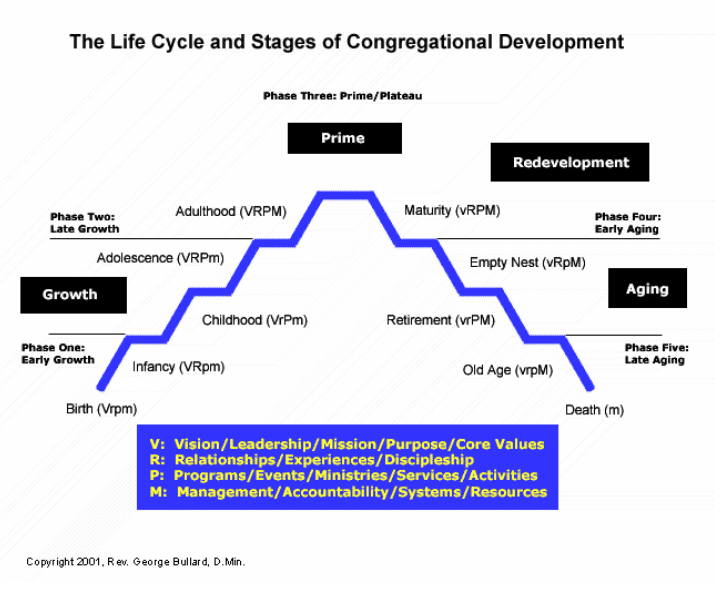
Ascent scale of a life cycle
- Birth – there's really only vision - it's someone’s idea.
- Infancy – the vision remains strong but relationships strengthen as a few people gather around the vision. There are no management structures and few activities or programmes outside the core gathering. As we move into childhood, team-dynamics result in relationships being strained.
- Adolescence – activities or programmes become strong and relationships strengthen as the congregation learns to work together - but still no proper management structures.
- Adulthood/Prime – appropriate levels of management structures are in place to support the vision programmes and relationships are strong.
Descent scale of a congregation
- Maturity – management structures become too unwieldly and detract from the vision. To resolve this typically more management structures are put in place.
- Empty Nesters – vision continues to weaken and the activities fall off. Relationships remain strong but management is stronger still.
- Bureaucracy/4th Age – vision continues to dwindle, relationships fail but interestingly effort is put into programmes in an attempt to get the show back on the road, but they are old fashioned harking back to the glory days. Management remains strong stopping any vision re-emerging.
- Death – only management remain.
Reflections
- This diagram may apply to a relatively small congregation or to groups and ministries within a large congregation as well as larger organisations.
- Maximum growth happens in the early stages of a lifecycle. If the congregation gets into the post prime stages, there may also be issues relating to lack of critical mass resulting limited energy to make change.
- There is nothing inevitable about growth or decline. By putting the emphasis on getting to prime it is possible to make this into a cycle rather than a linear pattern of life and death. Concentrating on re-envisioning, re-empowering and reducing unnecessary controls (management overhead), and allowing movement and development as the Spirit calls, can mean a return to prime from later years is possible.
- Development of a congregation depends more on spiritual leadership than on sociological factors.
- Changes in the society around the congregation or good or poor denominational actions can have a significant influence and this lifecycle needs to be seen within a particular context. Failure to understand the changing sociological nature of an area will mean that rather than shrinking, the vision will actually just be no longer appropriate. Therefore, an important factor is to maintain a focus on whether the vision is still relevant to the current situation.
- Times of revival (as a God thing) are discounted in this analysis.
- Even death can be reversed with the birth of a new congregation which has a Spirit-led vision. Consider and plan for the difficulties of new wine into old wine-skins (Mark 2: 22)
- Most congregations do not fit Bullard’s categories perfectly. However, one category usually predominates which enables a congregation to determine its current life cycle status.
- Congregations on the upward side of their life cycle can reach their peak and start down in seven years or less. This rapid movement, unlike the past, now occurs due to living in a culture where change has become the norm.
- Highly dysfunctional congregations (those that have been on the downside of their life cycle for a long time) usually need time to prepare to create a new life cycle. This preparation time can take from one to five years. However, once it begins the congregation probably has no more than two years to make the systemic changes required to start a new life cycle. It may take another three years to solidify the systemic changes that have been introduced. The preparation for change and the change process can be accelerated with outside help from either a denomination or the establishment of a mentoring relationship with either another congregation or consultant.
Congregations reaching the peak of their life cycle (adulthood) can not stay there for more than three to five years without beginning to decline. Such congregations need to create a new life cycle while they are at their peak.